八年级英语第八单元第二话题C部分市级优质课
仁爱版八年级英语下Unit8topic2SectionC优秀教学案例
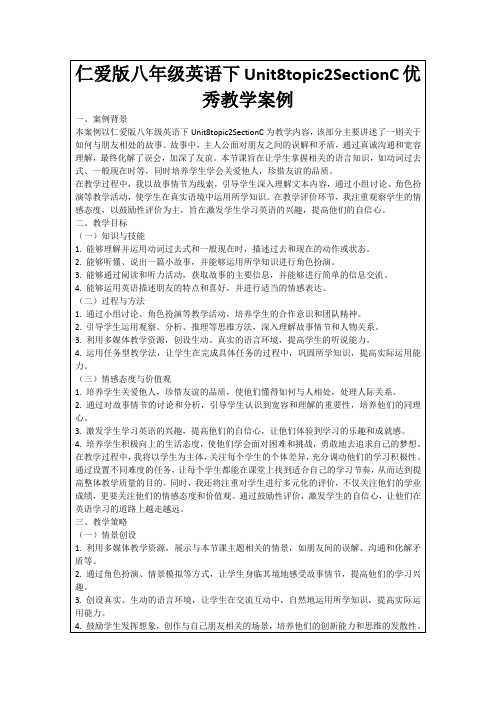
1.在课程结束后,引导学生对所学知识和技能进行总结,形成体系,提高他们的归纳能力。
2.鼓励学生对自己的学习过程进行反思,发现优点和不足,制定相应的改进措施。
3.采用多元化的评价方式,关注学生的学业成绩、情感态度和价值观,进行全面评价。
4.注重评价的激励作用,鼓励学生树立自信,勇敢地面对困难和挑战。
在教学过程中,我将根据学生的实际情况,灵活运用各种教学策略,确保每个学生都能在课堂上得到充分的关注和发展。同时,我还将在教学过程中不断调整和完善教学策略,以适应学生的需求和提高教学效果。通过这样的教学方式,我相信学生们一定能够在英语学习的道路上取得优异的成绩,同时也培养出良好的情感态度和价值观。
四、教学内容与过程
2.能够听懂、说出一篇小故事,并能够运用所学知识进行角色扮演。
3.能够通过阅读和听力活动,获取故事的主要信息,并能够进行简单的信息交流。
4.能够运用英语描述朋友的特点和喜好,并进行适当的情感表达。
(二)过程与方法
1.通过小组讨论、角色扮演等教学活动,培养学生的合作意识和团队精神。
2.引导学生运用观察、分析、推理等思维方法,深入理解故事情节和人物关系。
(一)导入新课
1.利用多媒体展示一组关于朋友间相处的照片,引导学生思考和朋友相处的美好时光,以及可能遇到的矛盾和误会。
2.邀请学生分享他们与朋友之间的趣事或误会,激发学生的学习兴趣,营造轻松、愉快的课堂氛围。
3.简要介绍本节课的主题和目标,让学生明确学习任务,激发他们的学习动力。
(二)讲授新知
1.通过PPT展示本节课的主要知识点 Nhomakorabea如动词过去式、一般现在时等,并用例句进行解释。
2.鼓励学生进行自我评价,发现自己的不足,制定相应的改进措施。
仁爱版英语八年级下Unit8Topic2SectionC参考教案

仁爱版英语八年级下Unit8Topic2SectionC参考教案Unit8 Topic2 SectionC 参考教案Ⅰ. Material analysis本节课建议教师用1课时上完。
主要活动为Section C 的1a和2。
本节课让学生通过1a的学习了解不同职业的不同着装及其重要性,复习了时间状语从句和条件状语从句,复习了动词不定式做目的状语的用法。
通过本课的学习,让学生对服装文化有更深刻的理解,让他们意识到职业服装的意义不仅仅停留在表面的信息化上,更体现在内在的功能化方面。
Ⅱ. Teaching aimsKnowledge aims:1. 复习时间状语从句和条件状语从句。
2. 复习动词不定式作目的状语的用法。
3. 谈论不同职业的不同着装及其重要性。
4. 了解不同季节的着装艺术。
Skill aims:1. 能听懂接近正常语速、涉及服装的语段,获取主要信息。
2. 能引出服装的话题并进行简单的交谈。
3. 能从简单的文章中找出有关信息,理解大意。
4. 能根据写作要求和素材,整理出符合逻辑的短文。
Emotional aims:对服装文化有更深刻的理解。
Ⅲ. The key points and difficult pointsKey points:1. 复习时间状语从句和条件状语从句。
2. 谈论不同职业的不同着装及其重要性。
3. 了解不同季节的着装艺术。
Difficult points:1. 学习运用功能句正确地阐述穿着职业装的目的。
2. 根据要求,运用本节知识重点整理出符合逻辑的短文。
Ⅳ. Learning strategies写作时要有鲜明的观点才能保证文章脉络的清晰。
Ⅴ. Teaching aidsComputer multimedia projector; the pictures of an official, boots, and the four seasons. Ⅵ. Teaching proceduresIntroduction(8 minutes)1. Greet students and make them ready for learning.2. The teacher shows the pictures of 2 in Section B. Let students make sentences with the structures It’s + adj. + (for sb. ) to do sth. and It’s + adj. + that …3. The teacher shows the pictures of 1a in Section B and the key words on the screen. Let students act out the four conversations with Could you tell me…? and You should/ have to…4. The teacher presents some sentences about dressing. Let students judge whether they are suitable or not. If not, let students correct them orally.For example:(1) When I am at home, I should wear a business suit.(2) If I go to a formal party, I should wear jeans.(3) When I am playing basketball, I should wear leather shoes.(4) When we have P.E. classes, we should wear sports shoes.5. The teacher summarizes and leads to 1a: It’s very important to wear suitable clothes on every occasion in our daily life, or in our everyday life. Some people have to wear their uniforms when they are at work. Let’s learn some of them.Presentation (10 minutes)1. The teacher lets students look at Picture 1 of 1a and addsa picture of officials. Let students discuss the jobs of the peoplein the pictures with their partner. Teach the words firefighter, heat and ceiling by introducing the firefighter in the picture. Teach the words soldier, official, officer and patients by showing their pictures. Teach the word airport by explaining that the pilot works in the airport. Teach the words reason and spread by showing their Chinese meanings.2. The teacher asks students to observe the pictures again and discuss what functions of their uniforms are.3. The teacher lets two or three students speak out their opinions.4. The teacher asks students to skim the passage and compare their opinions with the writer’s.5. The teacher asks students to read the passage again and answer the questions: How many kinds of uniforms are there in the text? What are they? Teach the new word text.6. The teacher lets two or three students tell their answers.Consolidation (10 minutes)1. The teacher plays the recording sentence by sentence.2. The teacher plays the recording without stopping.3. The teacher asks students to complete the table of 1b.4. The teacher asks two students to tell the answers. Remind them to pay attention to the usage of infinitives (to +v.).5. The teacher lets students find out the object clauses, adverbial clauses of time and condition as well as difficult points. Solve the difficult points together with the students.(1) Firefighters wear special coats and helmets to protect themselves from heat and falling ceilings.(2) When we see airline pilots wearing uniforms at the airport, we believe that they know how to fly the plane.(3) If we have a car accident on the street and we see a policeofficer in uniform, we know we can get help from him or her.6. The teacher lets students prepare to retell the passage with the help of 1b within their groups.Practice (10 minutes)1. The teacher lets students discuss with their group members whether students should wear uniforms at school. Allow them to have their own opinions. Teach the new word opinion and the phrase in one’s opinion.2. The teacher lets the representative of each group report their opinions.3. The teacher lets the students write a passage about the opinions of their own groups.4. The teacher evaluates their reports. And stress the advantage and importance ofdressing school uniforms.5. The teacher asks students to learn the new words in the brackets of 3a by themselves with the help of the similar words. Teach the new words boot and casual clothes by showing the pictures of them.(1) great →greatlybeautiful →beautifully(2) north +ern →northernsouth + ern →southerneast + ern →easternwest+ ern →western6. The teacher lets students skim the passage of 3a and know about the general ideas. Then let them choose the correct words to complete the passage.7. The teacher lets two students report their answers.Production (7 minutes)1. The teacher asks the students to read 3a again and fill in the table of 3b.2. The teacher lets two students tell the answers.3. T he teacher lets students work in pairs. Let them survey their partner’s favorite clothes in different seasons and complete the table.Season Clothesspringsummerfallwinter4. The teacher lets students report the result of the survey.5. The teacher guides students to write a passage according to their report.6. The teacher lets two students write down their passages on the blackboard. Then revise them together with the students.7. The teacher shows the summary of this section to the students.8. The teacher assigns homework:(1) Review the summary after class.(2) Write a passage about your family’s job and their uniforms.(3) Preview section D.Teaching ReflectionStudents learn a lot about the importance of uniforms. Many of them didn’t like wearing the school uniforms before, but now they know it’s necessary for them to wear the school uniforms. The teacher may design more sentences or draw some pictures about dressing suiting different jobs, seasons, occasions and so on, let students judge whether they are suitable or not.Ⅶ. Blackboard designUnit 8 Our ClothesTopic 2 We can design our own uniforms.Section C1. Firefighters wear special coats and helmets to protect themselves from heat and falling ceilings.2. When we see airline pilots wearing uniforms at the airport, we believe that they know how to fly the plane.3. If we have a car accident on the street and wesee a police officer in uniform, we know we canget help from him or her.1. great →greatlybeautiful →beautifully2. north +ern →northernsouth + ern →southerneast + ern →easternwest+ ern →western。
仁爱版八年级英语下Unit8topic2SectionC教学设计

c.教师在课堂上关注学生的情感需求,给予鼓励和肯定,帮助学生建立自信。
四、教学内容与过程
(一)导入新课
1.教师通过向学生展示一组成功人士的图片,引导学生思考:“What do you think makes these people successful?”,让学生分享他们对成功的看法。
1.培养学生的自信心,使他们相信只要付出努力,就能取得成功。
2.培养学生关爱他人,学会为他人取得的成就表示祝贺,增进同学之间的友谊。
3.引导学生认识到成功不仅仅是个人的努力,还需要团队合作和互相帮助。
4.培养学生积极向上的心态,面对困难和挑战时,保持乐观,勇敢面对。
5.通过学习本章节,使学生明白努力和坚持是通往成功的关键,激发他们为实现自己的人生目标而努力奋斗。
(二)教学设想
1.针对词汇和语法教学,采用以下设想:
a.设计丰富多样的词汇练习,如填空、选择、连线等,让学生在练习中巩固词汇。
b.结合实际语境,让学生运用目标词汇和句型进行角色扮演、小组讨论等活动,提高学生的语言运用能力。
c.通过具体实例,讲解一般现在时和一般过去时的区别与联系,让学生在实际语境中感受时态的运用。
(五)总结归纳
1.教师引导学生回顾ห้องสมุดไป่ตู้节课所学内容,总结词汇、语法、阅读、听力、口语等方面的知识点。
2.教师强调努力和坚持的重要性,鼓励学生在今后的学习生活中,积极面对挑战,为实现自己的目标而努力奋斗。
3.教师对本节课学生的表现给予肯定和鼓励,激发学生学习英语的自信心和积极性。
直接输出:
五、作业布置
为了巩固本节课所学的知识,教师设计了以下作业:
a.提供丰富多样的听力材料,如新闻、故事、对话等,让学生在听力实践中提高听力技巧。
人教新目标英语八年级上册Unit8SectionA(2d3c)课时优秀教学案例

作为一名特级教师,我深知一个优秀教学案例的亮点对于课堂教学的重要性。在本节课中,我努力将教学内容与学生实际相结合,注重激发学生的学习兴趣,培养他们的语言运用能力和思维能力。同时,我关注学生的个体差异,因材施教,使每个学生都能在课堂上得到有效的学习和提高。通过本节课的教学,我相信学生将能够掌握一般过去时态的知识与技能,提高英语学习的兴趣和自信心,培养正确的情感态度与价值观。
人教新目标英语八年级上册Unit8SectionA(2d3c)课时优秀教学案例
一、案例背景
本案例背景以人教新目标英语八年级上册Unit8 SectionA(2d3c)为例,本节课主要围绕一般过去时态进行教学。通过对过去发生的事情进行描述,培养学生的听说读写能力,并帮助他们掌握一般过去时态的构成和用法。
2.教师通过问答方式检查学生对一般过去时态的掌握程度,如:“你们能用一般过去时态描述一下你们昨天做了什么吗?”
3.教师强调一般过去时态在日常交流中的重要性,鼓励学生在日常生活中多运用一般过去时态。
(五)作业小结
1.教师布置一道作业:让学生写一篇短文,描述自己的一次难忘的过去经历,要求运用一般过去时态。
在学科上,英语作为一门语言学科,注重培养学生的人文素养和语言实际运用能力。本节课通过听力、口语、阅读和写作等多种教学活动,让学生在实际语境中感知、理解和运用一般过去时态。在课程内容上,以2d3c部分的文本为例,通过描述过去发生的日常活动,引导学生理解和运用一般过去时态,培养他们的语言运用能力和思维能力。
五、案例亮点
1.情景创设丰富多样:本节课通过播放英文歌曲、展示图片和视频等多种方式,为学生创设了丰富多样的情景,使学生在实际语境中感知、理解和运用一般过去时态。这种情境教学法不仅激发了学生的学习兴趣,还提高了他们的语言实际运用能力。
仁爱版八年级英语下册说课稿:Unit8Topic2SectionC
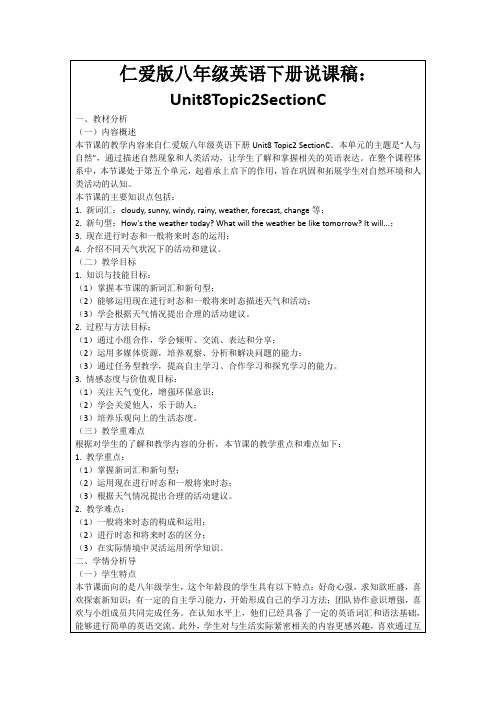
1.新词汇:cloudy, sunny, windy, rainy, weather, forecast, change等;
2.新句型:How's the weather today? What will the weather be like tomorrow? It will...;
(2)运用多媒体资源,培养观察、分析和解决问题的能力;
(3)通过任务型教学,提高自主学习、合作学习和探究学习的能力。
3.情感态度与价值观目标:
(1)关注天气变化,增强环保意识;
(2)学会关爱他人,乐于助人;
(3)培养乐观向上的生活态度。
(三)教学重难点
根据对学生的了解和教学内容的分析,本节课的教学重点和难点如下:
(二)媒体资源
在教学过程中,我将使用以下教具、多媒体资源和技术工具:
1.教具:实物、图片、卡片等,用于展示和描述天气情况,激发学生的学习兴趣;
2.多媒体资源:PPT、视频、音频等,展示不同天气的实景,帮助学生更好地理解教学内容;
3.技术工具:电子白板、投影仪等,实现课堂教学的现代化,提高课堂效率。
这些媒体资源在教学中的作用主要有:提供丰富的教学情境,增强课堂趣味性;直观展示教学内容,便于学生理解和记忆;实现师生互动,提高学生的参与度。
1.教学重点:
(1)掌握新词汇和新句型;
(2)运用现在进行时态和Байду номын сангаас般将来时态;
(3)根据天气情况提出合理的活动建议。
2.教学难点:
(1)一般将来时态的构成和运用;
(2)进行时态和将来时态的区分;
(3)在实际情境中灵活运用所学知识。
二、学情分析导
(一)学生特点
八年级英语仁爱版下册_Unit8_Topic2_SectionC_优质课课件
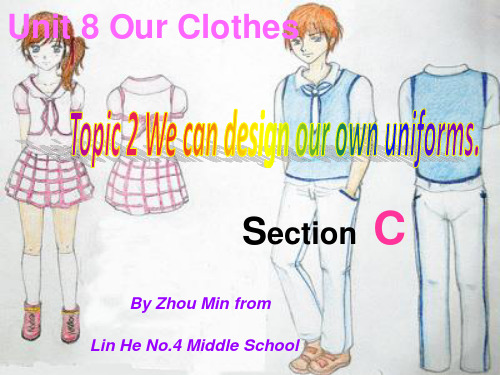
eyes __f_r_o_m___the sun.
读后抓巩固
3.当我们在机场看见航空公司飞行员穿着制服时, 我们相信他们知道怎样驾驶飞机。
When we __se_e__airline pilots __w_e_a_r_in__g_ uniforms at the airport, we believe that they know __h_o_w__t_o____/_h_o_w__t_h_e_y_c_a_n__fl_y_ fly the plane. 4. 所以对于我们来说了解日常生活中的不同制服
Read and pay attention to the pronunciation and intonation. (朗读能力需加强)
读后抓巩固
1.消防人员穿特殊服装和戴头盔是为了保护他们自 己免受高温和坠落的天花板的伤害。
Firefighters wear special coats and helmets
magazine?
2. Because they can protect themselves from
2h.eWathaynddofafilrleinfigghcteeirlisnwgsea.r special coats and helmets?
33..WWheaktncoanwwweekcnaonwgieftwheelspeefraompohliicme oofrfihceerr. in uniform?
是有必要的。
So it's _n_e_c_e_ss_a_r_y_ for us ____to__k_n_o_w______ different uniforms ___i_n_o_u_r__d_a_il_y_l_i_fe___ficial uniforms
Unit8SectionA2d-3c教案2023-2024学年人教版八年级英语上册
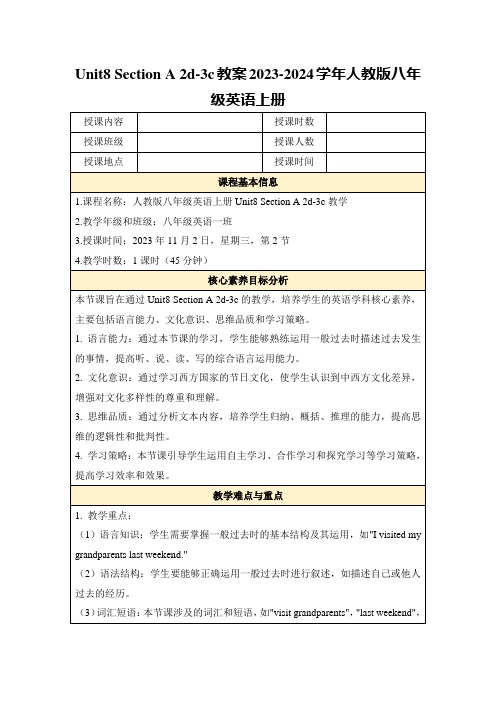
(一)教学特色创新
1.互动式学习:我在课堂上采用了互动式学习的方式,让学生在讨论和实践中掌握知识。例如,在讲解节日文化时,我让学生分享自己最喜欢的节日,并解释为什么喜欢,这样既提高了学生的参与度,又增强了他们的表达能力的信心。
2.情境教学:为了让学生更好地理解节日文化,我创设了各种真实的语境,如模拟旅行社、家庭聚会等,让学生在情境中学习和应用英语。
(3)在线工具:利用在线翻译工具,让学生了解节日相关词汇的英文表达。
(4)旅行日记模板:用于学生实践活动,编写关于自己过去某个周末的短文。
(5)节日卡片模板:用于学生实践活动,制作节日卡片,增进对文化差异的了解。
教学过程设计
1.导入新课(5分钟)
目标:引起学生对Unit8 Section A 2d-3c的兴趣,激发其探索欲望。
(4)阅读技能:学生需要能够理解并运用略读、寻读等技巧快速获取文本信息。
(5)文化意识:通过学习文本,使学生了解西方国家的节日文化及习俗,提高跨文化交际能力。
2.教学难点:
(1)一般过去时的运用:学生对一般过去时的构成和用法掌握不牢固,导致在实际运用中出现错误。
(2)文本理解:对于一些抽象的概念和细节,学生可能难以理解,如"I had a wonderful time last weekend."中的"wonderful time"可能不易理解。
过程:
简要回顾本节课的学习内容,包括节日文化的基本概念、组成部分、案例分析等。
强调节日文化在现实生活或学习中的价值和作用,鼓励学生进一步探索和应用节日文化。
布置课后作业:让学生撰写一篇关于节日文化的短文或报告,以巩固学习效果。
知识点梳理
仁爱版英语八年级下册教案:Unit 8 Topic 2 Section C
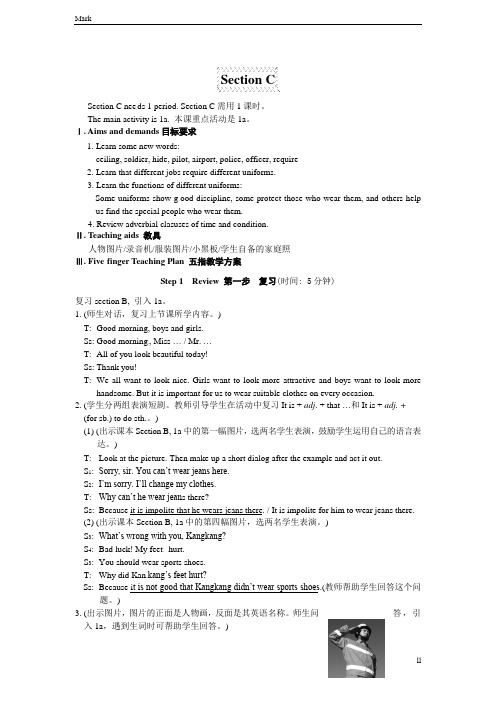
Section CSection C nee ds 1 period. Section C需用1课时。
The main activity is 1a. 本课重点活动是1a。
Ⅰ. Aims and demands目标要求1. Learn some new words:ceiling, soldier, hide, pilot, airport, police, officer, require2. Learn that different jobs require different uniforms.3. Learn the functions of different uniforms:Some uniforms show g ood discipline, some protect those who wear them, and others help us find the special people who wear them.4. Review adverbial clasuses of time and condition.Ⅱ. Teaching aids 教具人物图片/录音机/服装图片/小黑板/学生自备的家庭照Ⅲ. Five-finger Teaching Plan 五指教学方案Step 1 Review 第一步复习(时间: 5分钟)复习section B, 引入1a。
1. (师生对话,复习上节课所学内容。
)T: Good morning, boys and girls.Ss: Good morning, Miss … / Mr. …T: All of you look beautiful today!Ss: Thank you!T: W e all want to look nice. Girls want to look more attractive and boys want to look more handsome. But it is important for us to wear suitable clothes on every occasion.2. (学生分两组表演短剧。
人教八年级上册Unit8SectionA(2d3c)优秀教学案例
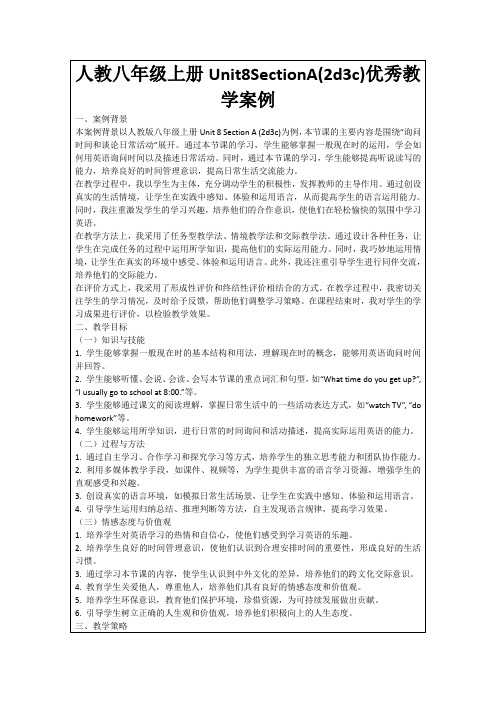
(四)反思与评价
1.学生自我反思:教师引导学生对自己的学习过程进行反思,总结学习方法和经验,提高自主学习能力。
2.同伴评价:学生相互之间进行评价,给出建设性意见,共同进步。
3.教师评价:教师对学生的学习成果进行评价,关注学生的成长,给予鼓励和指导。
2.任务型教学法的运用:教师设计了各种任务,让学生在完成任务的过程中运用所学知识。这种教学方法有助于培养学生的独立思考能力和团队协作能力,使学生在实践中提高语言运用能力。
3.跨文化交际的培养:教师利用图片、音频视频等材料,展示不同国家和地区的日常生活场景,引导学生关注文化差异。通过这种教学方式,学生能够增强跨文化交际意识,提高他们的综合素质。
在教学过程中,我以学生为主体,充分调动学生的积极性,发挥教师的主导作用。通过创设真实的生活情境,让学生在实践中感知、体验和运用语言,从而提高学生的语言运用能力。同时,我注重激发学生的学习兴趣,培养他们的合作意识,使他们在轻松愉快的氛围中学习英语。
在教学方法上,我采用了任务型教学法、情境教学法和交际教学法。通过设计各种任务,让学生在完成任务的过程中运用所学知识,提高他们的实际运用能力。同时,我巧妙地运用情境,让学生在真实的环境中感受、体验和运用语言。此外,我还注重引导学生进行同伴交流,培养他们的交际能力。
2.教师介绍本节课的重点词汇和句型,如“What time do you get up?”, “I usually go to school at 8:00.”等,并结合情境进行讲解和练习。
3.教师通过讲解和示范,引导学生掌握一般现在时的运用,让学生在实际情境中感知、体验和运用语言。
4.教师通过多媒体教学手段,如课件、视频等,为学生提供丰富的语言学习资源,增强学生的直观感受和兴趣。
仁爱版八年级下册Unit8Topic2SectionC优秀教学案例
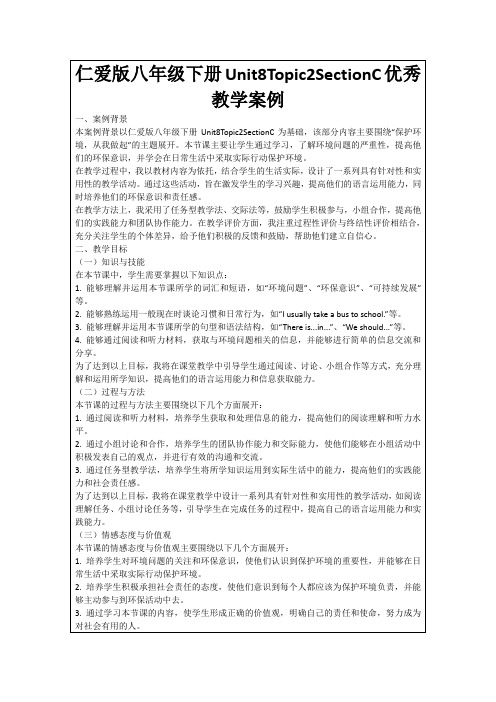
小组合作是一种有效的教学策略,能够培养学生的团队协作能力和交际能力。在本节课中,我将设计一些小组合作活动,如小组讨论、小组分享等,让学生在小组活动中积极发表自己的观点,并进行有效的沟通和交流。通过小组合作,学生能够更好地理解和运用所学知识,提高他们的实践能力和社会责任感。
(四)反思与评价
五、案例亮点
1.贴近生活实际的情景创设:本节课通过展示真实的环境问题图片和视频,以及设计贴近学生日常生活的角色扮演活动,让学生能够直观地感受到环境问题的严重性,并能够将所学知识运用到实际生活中,提高他们的实践能力和社会责任感。
2.问题导向激发思考:通过设计一系列的问题,引导学生进行思考和讨论,激发他们的思维能力和问题解决能力。问题导向教学策略使得学生能够更深入地理解环境问题的原因和解决方法,提高他们的思维能力和问题解决能力。
四、教学内容与过程
(一)导入新课
在导入新课时,我会通过展示一些与环境问题相关的图片或视频,引起学生的兴趣和关注。例如,我可以展示一些污染严重的河流、过度砍伐的森林等图片,让学生直观地感受到环境问题的严重性。接着,我可以提出一些问题,如“你们对这些环境问题有什么看法?你们认为是什么原因导致了这些问题?”等,引导学生进行思考和讨论。通过这样的导入方式,学生能够更好地进入学习状态,激发他们的学习兴趣和参与度。
(三)学生小组讨论
在学生小组讨论环节,我会设计一些与环境问题相关的话题,让学生在小组内进行讨论和交流。例如,我可以提出话题:“你们认为我们应该如何保护环境?你们在日常生活中有哪些环保习惯?”等。学生可以通过讨论,分享自己的观点和经验,并从其他同学那里获得不同的看法和建议。通过这样的小组讨论,学生能够提高自己的交际能力,培养团队合作精神,同时也能够加深对环保知识的理解和运用。
八年级上册英语Unit 8 Section A(2d-3c)公开课课件
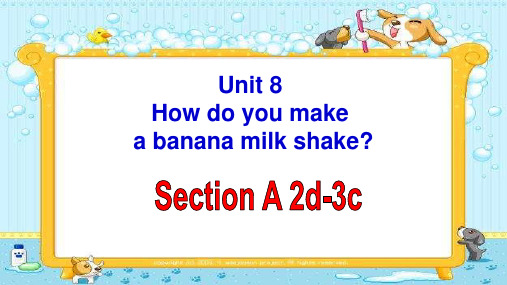
2.My sister helped me pour the water into the cup.
3.Please help me cut up the pears.I want to make fruit salad.
4.Remember to turn off the lights before you leave the
讲解:完成下列句子。
1. We need three cups of water. (提问) _____ ______ water do we need? How much 2. We need three cups of water. (提问) How many _____ ______ cups of water do we need? 3. They need ten tomatoes for the soup. (提问) How ______ many tomatoes do they need? _____
b. First; 句意“将玉米放进爆米机里”,由 常 识可知,这是爆爆米花的第一件事情。 d. turn; 由空格后的on the machine,一词 可知空格处为turn一词,turn on打开。 finally; 由最后的一词“加点盐”,可知 这 是最后一件事情,故应填finally一词。
Check the answers. ___ b 1. How do you make popcorn? ___ a 2. How much corn do we need? ___ d 3. What do we do next? ___ e 4. How much salt do we need? ___ c 5. Now can we eat it? a. Half a cup. b. First, put the corn into the popcorn machine. 机器 c. Yes, we can! d. Next, Turn on the machine. Finally, add the salt. e. Just one spoon.
仁爱版英语八年级下册教案:Unit 8 Topic 2 Section C

Section CSection C nee ds 1 period. Section C需用1课时。
The main activity is 1a. 本课重点活动是1a。
Ⅰ. Aims and demands目标要求1. Learn some new words:ceiling, soldier, hide, pilot, airport, police, officer, require2. Learn that different jobs require different uniforms.3. Learn the functions of different uniforms:Some uniforms show g ood discipline, some protect those who wear them, and others help us find the special people who wear them.4. Review adverbial clasuses of time and condition.Ⅱ. Teaching aids 教具人物图片/录音机/服装图片/小黑板/学生自备的家庭照Ⅲ. Five-finger Teaching Plan 五指教学方案Step 1 Review 第一步复习(时间: 5分钟)复习section B, 引入1a。
1. (师生对话,复习上节课所学内容。
)T: Good morning, boys and girls.Ss: Good morning, Miss … / Mr. …T: All of you look beautiful today!Ss: Thank you!T: W e all want to look nice. Girls want to look more attractive and boys want to look more handsome. But it is important for us to wear suitable clothes on every occasion.2. (学生分两组表演短剧。
新仁爱版八年级英语下册Unit8Topic2SectionC教案
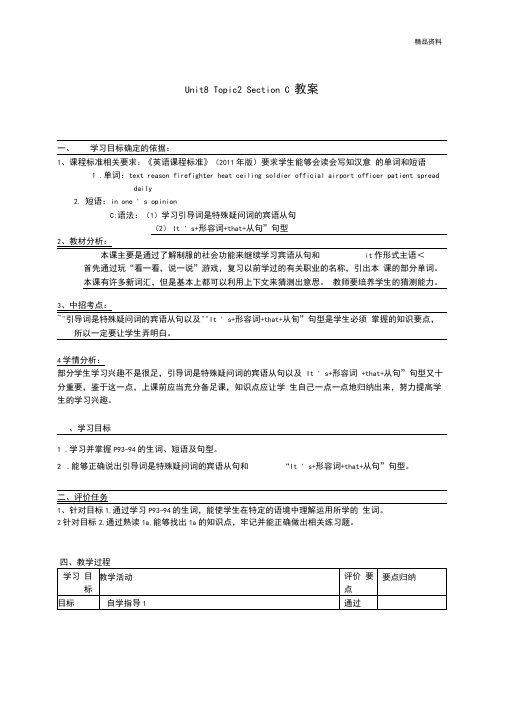
Unit8 Topic2 Section C 教案一、学习目标确定的依据:1、课程标准相关要求:《英语课程标准》(2011年版)要求学生能够会读会写知汉意的单词和短语1.单词:text reason firefighter heat ceiling soldier official airport officer patient spreaddaily2. 短语:in one ' s opinionC:语法:(1)学习引导词是特殊疑问词的宾语从句(2)It ' s+形容词+that+从句”句型2、教材分析:本课主要是通过了解制服的社会功能来继续学习宾语从句和it作形式主语<首先通过玩“看一看,说一说”游戏,复习以前学过的有关职业的名称,引出本课的部分单词。
本课有许多新词汇,但是基本上都可以利用上下文来猜测出意思。
教师要培养学生的猜测能力。
3、中招考点:~"引导词是特殊疑问词的宾语从句以及""It ' s+形容词+that+从旬”句型是学生必须掌握的知识要点,所以一定要让学生弄明白。
4学情分析:部分学生学习兴趣不是很足,引导词是特殊疑问词的宾语从句以及It ' s+形容词+that+从句”句型又十分重要,鉴于这一点,上课前应当充分备足课,知识点应让学生自己一点一点地归纳出来,努力提高学生的学习兴趣。
、学习目标1.学习并掌握P93-94的生词、短语及句型。
2.能够正确说出引导词是特殊疑问词的宾语从句和“It ' s+形容词+that+从句”句型。
二、评价任务1、针对目标1,通过学习P93-94的生词,能使学生在特定的语境中理解运用所学的生词。
2针对目标2,通过熟读1a,能够找出1a的知识点,牢记并能正确做出相关练习题。
八年级下册英语教案设计unit8. Topic2. Section C
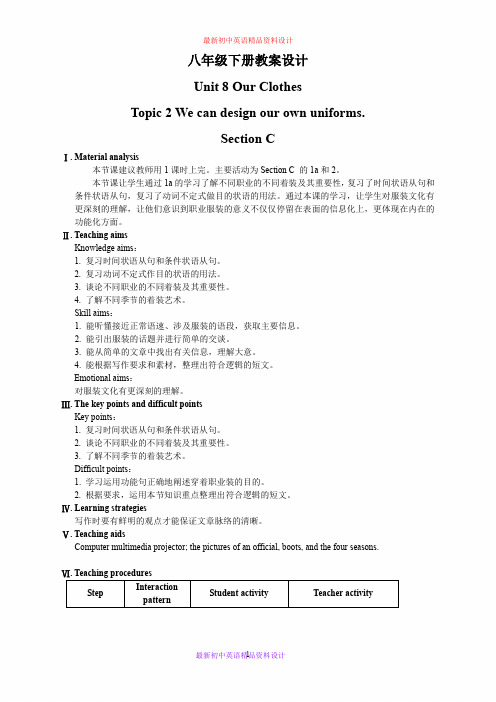
八年级下册教案设计Unit 8 Our ClothesTopic 2 We can design our own uniforms.Section CⅠ. Material analysis本节课建议教师用1课时上完。
主要活动为Section C 的1a和2。
本节课让学生通过1a的学习了解不同职业的不同着装及其重要性,复习了时间状语从句和条件状语从句,复习了动词不定式做目的状语的用法。
通过本课的学习,让学生对服装文化有更深刻的理解,让他们意识到职业服装的意义不仅仅停留在表面的信息化上,更体现在内在的功能化方面。
Ⅱ. Teaching aimsKnowledge aims:1. 复习时间状语从句和条件状语从句。
2. 复习动词不定式作目的状语的用法。
3. 谈论不同职业的不同着装及其重要性。
4. 了解不同季节的着装艺术。
Skill aims:1. 能听懂接近正常语速、涉及服装的语段,获取主要信息。
2. 能引出服装的话题并进行简单的交谈。
3. 能从简单的文章中找出有关信息,理解大意。
4. 能根据写作要求和素材,整理出符合逻辑的短文。
Emotional aims:对服装文化有更深刻的理解。
Ⅲ. The key points and difficult pointsKey points:1. 复习时间状语从句和条件状语从句。
2. 谈论不同职业的不同着装及其重要性。
3. 了解不同季节的着装艺术。
Difficult points:1. 学习运用功能句正确地阐述穿着职业装的目的。
2. 根据要求,运用本节知识重点整理出符合逻辑的短文。
Ⅳ. Learning strategies写作时要有鲜明的观点才能保证文章脉络的清晰。
Ⅴ. Teaching aidsComputer multimedia projector; the pictures of an official, boots, and the four seasons.Ⅵ. Teaching proceduresStep InteractionpatternStudent activity Teacher activityntroduction (8 minutes)1. The wholeclass work.2. The wholeclass work.3. Pair work.4. The wholeclass work..5. The wholeclass work.1. Focus their attentionon the teacher.2. Students make sentenceswith the structures It’s+ adj. + (for sb. ) todo sth. and I t’s + adj. +that …3. Students act out thefour conversations withCould you tell me…?and You should/ haveto…4. Students judge whetherthese sentences aresuitable or not.5. Students should havethe right sense: we mustwear suitable clothes onevery occasion in ourdaily life. Learn the newword daily with thehelp of the teacher.1. Greet students and makethem ready for learning.2. The teacher shows the picturesof 2 in Section B. Letstudents make sentenceswith the structures It’s+adj. + (for sb. ) to do sth.and I t’s + adj. + that …3. The teacher shows the picturesof 1a in Section B and thekey words on the screen.Let students act out the fourconversations with Couldyou tell me…? and Youshould/ have to…4. The teacher presents somesentences about dressing.Let students judge whetherthey are suitable or not. If not,let students correct them orally.For example:(1) When I am at home, Ishould wear a businesssuit.(2) If I go to a formal party,I should wear jeans.(3) When I am playingbasketball, I shouldwear leather shoes.(4) When we have P.E.classes, we should wearsports shoes.5. The teacher summarizes andleads to 1a: It’s very importantto wear suitable clotheson every occasion in our dailylife, or in our everyday life.Some people have to weartheir uniforms when theyare at work. Let’s learnsome of them.Presentation (10 minutes) 1. Pair work.2. Group work.3. Two or threestudents’ work.4. Individualwork.5. The wholeclass work.6. The wholeclass work.1. Students discuss thejobs of the people inthe pictures with theirpartner. Learn and masterthe new words withthe help of the teacher.2. Students observe thepictures again and discusswhat functions of theiruniforms are.3. Students speak outtheir opinions.4. Students skim thepassage and comparetheir opinions with thewriter’s.5. Students read the passageagain and answer thequestions.6. Students check theanswers.1. The teacher lets studentslook at Picture 1 of 1aand adds a picture ofofficials. Let studentsdiscuss the jobs of thepeople in the pictures withtheir partner. T each the wordsfirefighter, heat and ceilingbyintroducing the firefighterin the picture. T each the wordssoldier, official, officerand patients by showingtheir pictures. Teach the wordairport by explaining thatthe pilot works in the airport.T each the words reason andspread by showing theirChinese meanings.2. The teacher asks studentsto observe the pictures againand discuss what functionsof their uniforms are.3. The teacher lets two orthree students speak outtheir opinions.4. The teacher asks studentsto skim the passage andcompare their opinions withthe writer’s.5. The teacher asks studentsto read the passage againand answer the questions:How many kinds of uniformsare there in the text?What are they? Teach thenew word text.6. The teacher lets two orthree students tell theiranswers.Consolidation (10 minutes) 1. The wholeclass work2. The wholeclass work3. Individualwork.4. The wholeclass work.5. Individualwork + thewhold classwork.6. Group work.1. Students read the passageafter the recordingsentence by sentence.2. Students try to followthe speed, paying attentionto the pronunciationand intonation.3. Students read 1a andcomplete the table of1b.4. Students check theanswers.5. Students read the passageand find out the mainpoints. Understand thepassage with the helpof the teacher.6. Students prepare to retellthe passage with the helpof 1b within their groups.1. The teacher plays the recordingsentence by sentence.2. The teacher plays therecording without stopping.3. The teacher asks students tocomplete the table of 1b.4. The teacher asks two studentsto tell the answers. Remindthem to pay attention tothe usage of infinitives (to+v.).5. The teacher lets students findout the object clauses,adverbial clauses of timeand condition as well asdifficult points. Solve thedifficult points togetherwith the students.(1) Firefighters wear specialcoats and helmets toprotect themselves fromheat and falling ceilings.(2) When we see airlinepilots wearing uniformsat the airport, we believethat they know how tofly the plane.(3) If we have a car accidenton the street and wesee a police officer inuniform, we know wecan get help from himor her.6. The teacher lets students prepareto retell the passage with thehelp of 1b within their groups.Practice (10 minutes) 1. Group work.2. The wholeclass work.3. Individualwork.4. The wholeclass work.5. The wholeclass work.6. Individualwork.7. The wholeclass work.1. Students discuss withtheir group memberswhether students shouldwear uniforms at school.2. Students report theiropinions.3. Students write a passageabout the opinions oftheir own groups.4. Students should knowmore about the advantageand importance ofdressing school uniforms.5. Students learn the newwords in the bracketsof 3a by themselveswith the help of thesimilar words.6. Students choose thecorrect words to completethe passage.7. Students check theanswers.1. The teacher lets studentsdiscuss with their groupmembers whether studentsshould wear uniforms atschool. Allow them tohave their own opinions. T eachthe new word opinion andthe phrase in one’s opinion.2. The teacher lets therepresentative of eachgroup report their opinions.3. The teacher lets the studentswrite a passage about theopinions of their own groups.4. The teacher evaluates theirreports. And stress theadvantage and importanceof dressing school uniforms.5. The teacher asks students tolearn the new words inthe brackets of 3a bythemselves with the helpof the similar words.Teach the new words bootand casual clothes byshowing the pictures of them.(1) great →greatlybeautiful →beautifully(2) north +ern →northernsouth + ern →southerneast + ern →easternwest+ ern →western6. The teacher lets students skimthe passage of 3a and knowabout the general ideas.Then let them choose thecorrect words to completethe passage.7. The teacher lets two studentsreport their answers.Production (7 minutes) 1. Individualwork.2. The wholeclass work.3. Pair work.4. The wholeclass work5. Individualwork.6. The wholeclass work.7. The wholeclass work.8. Individualwork1. Students read 3a againand fill in the table of3b.2. Students check theanswers.3. Students survey theirpartner’s favorite clothesin different seasons,and complete the table.4. Students report theresult of the survey.5. Students write a passageaccording to their report.6. Students revise thepassages written onthe blackboard.7. Students summarizeSection C with theteacher.8. Students finish afterclass.1. The teacher asks the studentsto read 3a again and fill inthe table of 3b.2. The teacher lets two studentstell the answers.3. The teacher lets students workin pairs. Let them surveytheir partner’s favoriteclothes in different seasonsand complete the table.Season Clothesspringsummerfallwinter4. The teacher lets students reportthe result of the survey.5. The teacher guides studentsto write a passage accordingto their report.6. The teacher lets two studentswrite down their passageson the blackboard. Thenrevise them together withthe students.7. The teacher shows thesummary of this sectionto the students.8. The teacher assigns homework:(1) Review the summaryafter class.(2) Write a passage aboutyour family’s job andtheir uniforms.(3) Preview section D.Teaching ReflectionStudents learn a lot about the importance of uniforms. Many of them didn’t like wearing the school uniforms before, but now they know it’s necessary for them to wear the school uniforms. The teacher may design more sentences or draw some pictures about dressing suiting different jobs, seasons, occasions and so on, let students judge whether they are suitable or not.Ⅶ. Blackboard designUnit 8 Our ClothesTopic 2 We can design our own uniforms.Section C1. Firefighters wear special coats and helmets to protectthemselves from heat and falling ceilings.2. When we see airline pilots wearing uniforms at the airport, we believe that they know how to fly the plane.3. If we have a car accident on the street and wesee a police officer in uniform, we know we canget help from him or her. 1. great →greatly beautiful →beautifully 2. north +ern →northern south + ern →southern east + ern →eastern west+ ern →western。
仁爱版八年级英语unit8topic2教案
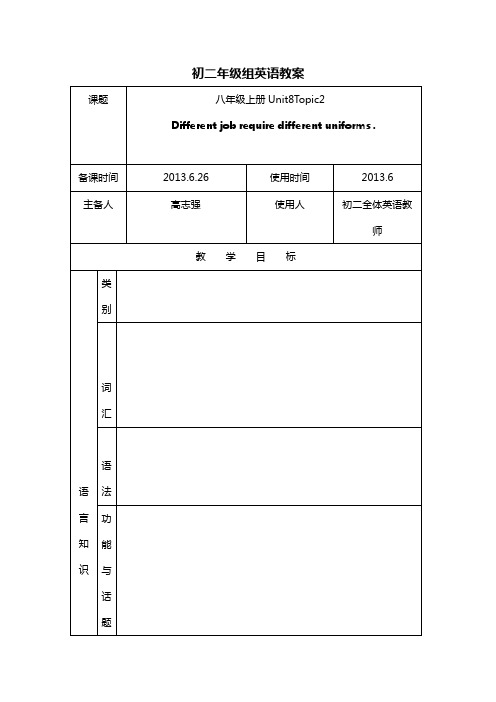
初二年级组英语教案课题八年级上册Unit8Topic2Different job require different uniforms .备课时间2013.6.26 使用时间2013.6主备人高志强使用人初二全体英语教师教学目标语言知识类别词汇语法功能与话题语言技能听 1. 说 1.读 1.写情感态度1.学习策略1.教学过程Section A 修改建议Language points1. allow vt.,意为“允许”。
allow sb. to do sth. 表示“允许某人做某事”。
e.g.My parents don’t allow me to watch TV too late.我父母不允许我看电视看得太晚。
allow后面可接v.-ing形式。
e.g.We don’t allow talking with each other in class. 我们不允许在课堂上互相交谈。
plain clothes 便服Soldiers wear plain clothes on leave, not uniform.士兵度假时穿便服,不穿制服。
interview v. 采访I’ll interview an office worker this afternoon.2. carry out 贯彻;执行;实现e.g.They didn’t carry out their plan.他们没有执行他们的计划。
She had finally carried out her promise to stop smoking. 她最终实现了戒烟的诺言。
The boss wanted his workers ____ the plan soon.A. carry outB. to carry outC. carried outD. carrying out3. depend on 依靠depend on +sb. / sth.Children depend on their parents for food and clothing.儿童的衣食靠父母。
仁爱版英语八年级下册Unit8Topic2SectionC优秀教学案例
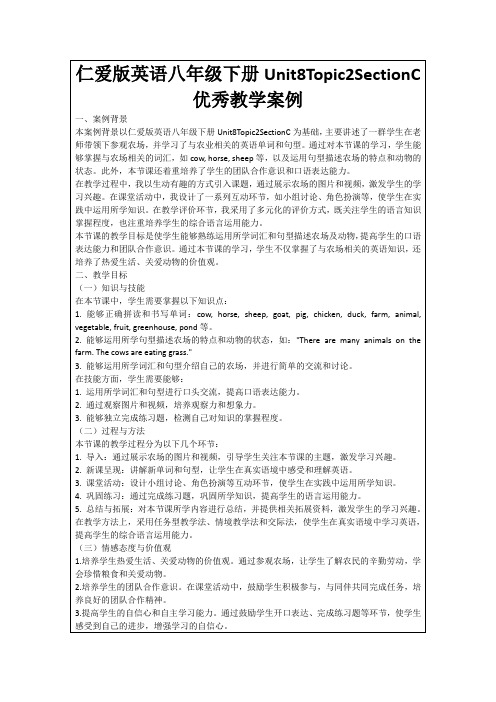
(一)导入新课
在导入新课时,我采用了一种生动有趣的方式,以引起学生的兴趣和好奇心。我通过展示农场的图片和视频,让学生初步了解农场的生活和环境。然后,我向学生提出问题:“Do you like farms? Why?”,引导学生思考和表达自己对农场的看法。通过这种方式,学生能够激发对农场的兴趣,自然地引入新课的学习。
5.多元化的教学评价:我采用了多元化的评价方式,既关注学生的语言知识掌握程度,也注重培养学生的综合语言运用能力。通过这种全面的评价方式,我能够更好地了解学生的学习成果和潜力,为下一步的教学提供有效的反馈和指导。
4.培养学生的批判性思维能力。在课堂讨论中,鼓励学生发表自己的观点,学会倾听他人的意见,培养批判性思维。
三、教学策略
(一)情景创设
在本节课的教学中,我采用了情境教学法,通过创设真实的农场情境,激发学生的学习兴趣和参与欲望。我利用多媒体展示农场的图片和视频,让学生仿佛置身于农场之中,感受到农场的氛围。同时,我还设计了一系列与农场相关的场景,如农场主介绍农场、学生参观农场、讨论农场的特点等,使学生在真实语境中学习和运用英语。
3.小组合作学习:我组织学生进行小组讨论和角色扮演等活动,培养了学生的团队合作意识和沟通能力。通过小组合作学习,学生能够相互学习、共同进步,提高了口语表达能力和综合语言运用能力。
4.反思与评价:在课堂的结束阶段,我组织学生进行反思和评价,帮助他们总结经验、提高学习能力。学生能够更好地了解自己的学习情况,发现自己的优点和不足,从而更好地指导自己的学习。
(三)学生小组讨论
在学生小组讨论环节,我设计了几个与农场相关的问题,让学生进行小组讨论。例如,我提出了问题:“What are the characteristics of a farm?”, “Can you describe the animals on the farm?”等。学生分组讨论,并用自己的语言进行描述和交流。通过小组讨论,学生能够巩固所学知识,提高口语表达能力和团队合作意识。
人教版八年级上册第八单元Section B 2a-2c 教案
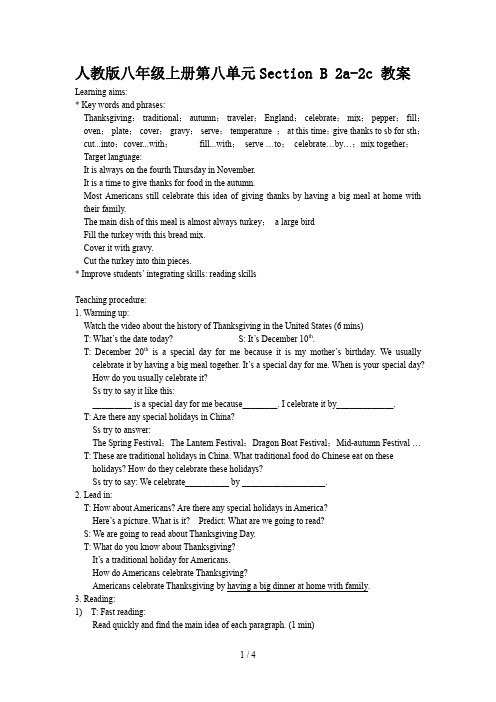
人教版八年级上册第八单元Section B 2a-2c 教案Learning aims:* Key words and phrases:Thanksgiving;traditional;autumn;traveler;England;celebrate;mix;pepper;fill;oven;plate;cover;gravy;serve;temperature ;at this time;give thanks to sb for sth;cut...into;cover...with;fill...with;serve …to;celebrate…by…;mix together;Target language:It is always on the fourth Thursday in November.It is a time to give thanks for food in the autumn.Most Americans still celebrate this idea of giving thanks by having a big meal at home with their family.The main dish of this meal is almost always turkey;a large birdFill the turkey with this bread mix.Cover it with gravy.Cut the turkey into thin pieces.* Improve students’ integrating skills: reading skillsTeaching procedure:1. Warming up:Watch the video about the history of Thanksgiving in the United States (6 mins)T: What’s the date today? S: It’s December 10th.T: December 20th is a special day for me because it is my mother’s birthday. We usually celebrate it by having a big meal together. It’s a special day for me. When is your special day?How do you usually celebrate it?Ss try to say it like this:_________ is a special day for me because________. I celebrate it by_____________.T: Are there any special holidays in China?Ss try to answer:The Spring Festival;The Lantern Festival;Dragon Boat Festival;Mid-autumn Festival …T: These are traditional holidays in China. What traditional food do Chinese eat on theseholidays? How do they celebrate these holidays?Ss try to say: We celebrate__________ by ___________________.2. Lead in:T: How about Americans? Are there any special holidays in America?Here’s a picture. What is it? Predict: What are we going to read?S: We are going to read about Thanksgiving Day.T: What do you know about Thanksgiving?It’s a traditional holiday for Americans.How do Americans celebrate Thanksgiving?Americans celebrate Thanksgiving by having a big dinner at home with family.3. Reading:1) T: Fast reading:Read quickly and find the main idea of each paragraph. (1 min)Para 1 : The introduction of ThanksgivingPara 2: Making a turkey dinner2) T: Careful reading(Para. 1) :Read slowly and answer T or F: Find the sentences have to do with the statements in thepassage.1. All countries usually have traditional food on special holidays. ( )2. Thanksgiving Day is to remember the first travelers. ( )3. On Thanksgiving Day ; American people get together on a big square (广场) to give thanks. ( )4. A turkey is almost always the main dish on American Thanksgiving.( ) Answer the questions about Thanksgiving3) Careful reading (Para. 2)T: What do we need to make a turkey dinner?Ss give answers: turkey ; bread pieces ; onions ; salt ; pepper ; gravy ; plate ; ;knife ; ovenT: Number the picturesSs give the answers by saying the phrasal verbs:1. mix together …2. fill …with…3. put …in …and cook …4. place …on …and cover …with5. cut …into …Ask students to say the instructions for making a turkey dinner ; according to the pictures ; with First ;…. Then ;…; Next ;…; When it is …; …. Finally ;…4) Finish 2d. Here are the instructions for making a turkey dinner written in a different way. Put them in order. Write First;Next;Then and Finally.5) Retell the whole passage according to the mind map.4. Groupwork:5. Homework:Write a short passage about a special festival. (Dragon Boat Festival;the Spring Festival;Mid-autumn Festival…)《Thanksgiving in the United States》教学反思温岭市实验学校杨丹蕴这节课的教学重点设计符合学生认知水平;学生学习中把握重点准确及时;针对重点训练能够及时达标。
- 1、下载文档前请自行甄别文档内容的完整性,平台不提供额外的编辑、内容补充、找答案等附加服务。
- 2、"仅部分预览"的文档,不可在线预览部分如存在完整性等问题,可反馈申请退款(可完整预览的文档不适用该条件!)。
- 3、如文档侵犯您的权益,请联系客服反馈,我们会尽快为您处理(人工客服工作时间:9:00-18:30)。
5.(
B
)When we are in trouble , we can ask --------- for help . A: doctors B: police officers C:firefighters D:officials
1b Read 1a again and complete the table.
to let us know we can get help from them to make patients find them easily and to
3a Choose the correct words to complete the passage. Then read it aloud. 系动词 副词修饰动词,放动词之后 +形容词(系表结构)
fire-fighter [ˈf aɪəfaɪtə]
消防队员
ceiling[ˈs i:lɪ ŋ]
n. 天花板
soldier airport [ˈeəp ɔ:t] [ˈs əʊldʒə] n.士兵 n ,战士 飞机场
officer [ˈ ɔ:fɪsə]
boot
[bu:t]
n.警官,军官(武) n. 长筒靴
firefighter
soldier official airline pilot police officer doctor
green clothes official uniforms
pilot uniforms police uniforms
to make us believe that they know how to fly the plane
3b Read 3a again and fill in the table.
Season
spring summer fall winter
ቤተ መጻሕፍቲ ባይዱ
Clothes
windbreaker shorts,T-shirs and dresses casual clothes, jeans sweater or other warm clothes, boots
Job student firefighter soldier official airline pilot Uniform school uniforms special coats and helmets green clothes official uniforms pilot uniforms Purpose to show good discipline to protect themselves from heat and falling ceilings to protect themselves in the forest to make themselves look important to make us believe that they know how to fly the plane to let us know we can get help from them to make patients find them easily and to stop the spread of diseases
A: doctors
3.(
B )Soldiers wear -------- clothes to protect them in the forests.
A: red B: green C:blue D:yellow
4.(
C
)When officials dress in their uniforms,they will look --------A: handsome B:cool C:important D: ugly
dress 连衣裙
uniform 制服,工作服
Do you like your school uniforms ?
1.学习并掌握P93----P94 生词及词组。
2.了解并熟悉生活中不同行业制服的作用。
3.掌握阅读短文速读和精读的两种技巧。
4.能独立完成Our School Uniforms的短文
heat
daily
[hi:t]
[ˈd eɪli]
n.温度,热量/v.加热
adj.日常的 n.日报
greatly
official
[ˈgr eɪtli]
[əˈf ɪʃl]
adv. 极大地,大大地
n.官员(文)
text
[tekst]
[ˈp eɪʃnt]
n.正文,文本
adv.漂亮地,美好地 n.病人 /adj. 有耐心
单项选择。
( B ) 1. It’s important for us ______ exercise an hour every day. A. do B. to do C. finishing D. finished ( C ) 2. Everyone should ______our lakes, rivers, seas and oceans ______pollution. A. protect, away B. protect, it C. protect, from D. protect, out ( D ) 3.____my opinion,students shouldn't smoke,it's bad___our health. A. On,for B.With,at C. In,at D. In,for ( B ) 4.We should help old people and children ____________. A. in the day life B.in the daily life C. at the day life D.on the daily life
1c
Job
student
Uniform
school uniforms special coats and helmets
Purpose
to show good discipline to protect themselves from heat and falling ceilings to protect themselves in the forest to make themselves look important
wind-breaker 风衣
a Korean windbreaker 一件韩版风衣
jacket
a leather jacket 一件皮夹克
tie
four ties 四条领带
shirt 衬衫(男)
blouse 衬衫(女)
handbag 手提包(女)
scarf 围巾
two scarves
两条围巾
police officer
doctor
police uniforms doctor uniforms
1. Firefighters wear special coats and helmets to protect themselves from heat and falling ceilings. 消防人员穿特殊服装和戴头盔是为了保护他们自己免受高温和坠落的天花 板的伤害。 (1)此句的“to + v.”意为“为了...” 是动词不定式作目的状语的用法。 E.g:我到北京去是为了参观长城。 I will go to Beijing to visit the Great Wall. (2)protect... from... “保护...... 免受......的伤害” E.g:我们戴太阳镜是为了保护眼睛免受阳光的伤害。 We wear sunglasses to protect our eyes from the sun. 2. When we see airline pilots wearing uniforms at the airport,we believe that they know how to fly the plane. 当我们在机场看见航空公司飞行员穿着制服时,我们相信他们知道怎样驾 驶飞机。 (1)when引导一个时间状语从句,在主句中又包含了由that引导的宾语从句, 宾语从句中有一个how to fly...的“疑问词+动词不定式”结构。 (2)wearing uniforms 现在分词作宾语补足语,修饰airline pilots。 3. So it's necessary for us to know different uniforms in the daily life. 所以对于我们来说了解日常生活中的不同制服是有必要的。 in the daily life 在日常生活中
11.由于不同的原因
1.(C )There are ---------- kinds of different uniforms A: five 2.( B: six C: seven D: eight
D
)If we dial 119 , the --------- will come at once . B:officials C:airline pilots D:firefighters
beautifully [ˈb ju:təfəlɪ] patient 的
opinion 点
[əˈp ɪnjən]
n.意见,想法,观
1.一双长筒靴
2.在日常生活中 3.在我看来
4.坍塌的天花板
5.警官 6.白云机场 7.在北部 8.《南阳日报》 9.许多消防官兵 10.把水加热
boots a pair of --------daily life in ----------opinion in my --------------ceilings falling ---------------officers police ---------------Airport Baiyun -----------------northern in the ---------------- part Daily Nanyang -------------firefighters many ----------------------heat the water ----------reasons for different ----------------
